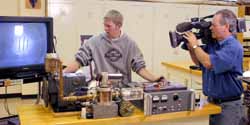Student builds nuclear fusion reactor
The usual electronic gadgetry in Science and Engineering Research Room 112 had to make way for video cameras, microphones, and studio lights yesterday morning as Craig Wallace coolly explained his contraption to correspondents for the Canadian Discovery Channel.
“Ever since I was a kid I’ve always loved science, you know, tinkering with things,” Wallace said.
But now Utah State University freshman and Intel International Science and Engineering Fair’s (ISEF) second-place winner is doing much more than tinkering. Wallace’s project, an inertial electrostatic confinement nuclear fusion reactor – also nicknamed “the Fusor” – not only hurled him to the top of the international science fair, but is now catching headlines across the nation and in Canada.
Wallace’s project placed second in the Intel ISEF, the world’s only international science fair, held this year in Cleveland, Ohio. The ISEF consists of more than 1,200 students from more than 40 different countries competing for prizes and scholarships. There, the Fusor was examined by eight judges, including the Nobel Prize Laureate, and was awarded the second-place prize overall.
Wallace’s machine concentrates plasma, or atoms pulled apart to create positive ions, and confines them within an electronic field created by a small electronic coil. When the positive ions rush together within the coil, they collide producing a pale blue glow. When a collision occurs just right, the two ions are fused together and free neutrons are released. The nuclear fusion reaction is the same type of reaction that takes place in nuclear power plants or even on the sun, just on a much smaller scale.
David Peak, assistant head of the physics department, said, “It’s like a miniature piece of the sun, except it uses an electronic field to pull the particles in instead of gravity like the sun uses.”
The fusion within the Fusor takes place at a small enough scale that cannot it be used as an energy source as other nuclear reactors are. However, the technology Wallace is helping to develop is important not because of the energy it produces, but because of the neutrons produced during the reaction.
Physics Department Head John Raitt said the concept behind Wallace’s machine could become, “a practical neutron source which is of considerable interest to homeland security because they can be used to detect hidden things in suitcases, like a type of an X-ray.”
Wallace further explained that the neutrons can be used to detect bomb-making materials such as phosphates or nitroglycerin the way normal X-rays can’t.
As fascinating as Wallace’s contraption is, the story of how he developed it is even more interesting. Wallace, a native of Spanish Fork, said that as a freshman in high school he was, “surfing the Internet one day and stumbled across a theory about inertial electrostatic confinement (IEC) and it led me to this design of a system.”
From the beginning, he planned on actually making the machine. All of his research and design was done independently, with only occasional encouragement from his high school, Spanish Fork High.
“I actually got started when I was a freshman, but it was finished and operating when I was a senior,” Wallace said.
Wallace’s high school sponsored him in the district science fair. Then after winning that, he went on to the State Science Fair at BYU and from there to the ISEF in Cleveland.
Wallace was introduced to the USU physics department by graduate student Jevin West, who met Wallace at the Logan Sports Academy through their common interest in tennis.
Commenting on how he introduced Wallace to Farrell Edwards and other members of the physics department, West said, “He’s impressed a lot of people.”
Raitt said he was delighted Wallace chose to attend USU. Wallace will attend through the end of fall semester and perhaps spring as well before leaving on a full-time LDS mission.
When asked if he will return to USU after his mission, Wallace replied, “Oh yes, definitely.”
-sjeppesen@cc.usu.edu

Craig Wallace, a freshman physics major, demonstrates his nuclear fusion reactor for Sam Prigg of White Rabbit Productions. Prigg was filming the device for Discovery Channel Canada. (Photos by Ryan Talbot)

